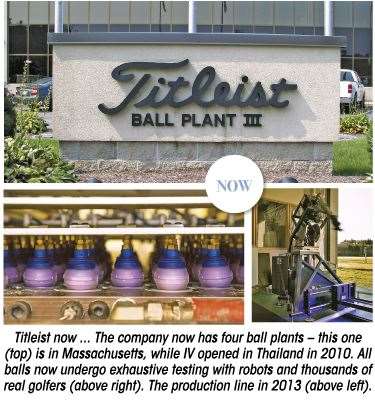80 years of experience, four manufacturing plants and 40,000 testers; just three of the things it takes for Titleist to produce ...
“We didn’t have a separate line we were making for tour players, so when an event would come into town we wanted to give players the opportunity to play that ball. They received a ‘chit’ to go into the golf shop and get four dozen free balls, which we would then replace. As popularity grew, and more players wanted to get that chit, spotting the Titleist representative was really important so the rep would start wearing a white coat on the range.”
 It’s clear that Titleist holds its heritage dear, as well as maintaining the core values that helped them develop into a market leader.
It’s clear that Titleist holds its heritage dear, as well as maintaining the core values that helped them develop into a market leader.
Today’s balls are a world away from those that were played in 1932, but certain fundamentals remain. “It starts with the precision process in our founding,” says Mahoney, “and making every single ball consistently the same – cores that were centred, consistent dimple coverage. Eighty years ago, balls had very simple constructions. I think the introduction of aerodynamic changes in the 1970s to give different trajectories, and the fact we offered players those different trajectories, and they put them in play and utilised them for different types of shot, really influenced the one-ball rule. So the understanding of aerodynamics would be one of the key moments.”
Then there was the shift to different materials from a cover standpoint with the introduction of balata. “That generated a spin profile that would allow players to really improve their short game shots, which are ultimately the shots that help players to shoot better scores.
“That said, spin and those constructions meant a sacrifice on some distance so probably the most important golf ball innovation was the introduction of the Pro V1 in 2000, combining solid core construction which gives you outstanding distance with the urethane cover which allows you to generate the same sort of spin profile on short shots that you were getting on those balata constructions.”
The Pro V1 franchise has been one of the most-successful in golf history, but developing this revolutionary new technology had its challenges.
“The biggest change was when we shifted from wound to solid core construction,” said Mahoney. “Taking those winding machines out of the plant and moving towards moving big batches of solid core materials – that is the most significant change that we made in the past ten or 20 years.
Related Articles

Motocaddy Australia throws support behind Cancer Council’s The Longest Day

Perfectly Fitting: The ultimate fitting guide













